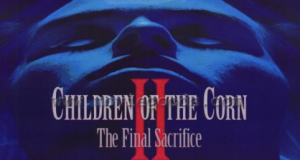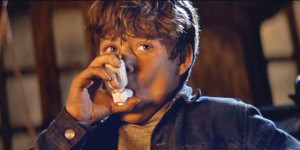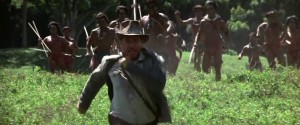Corn Connection: Thinnest threads in ‘Final Sacrifice’
In The Corn Connection, Venganza Media searches the Now Playing Podcast archives for films featuring the cast of The Children of the Corn series
Children of the Corn II: The Final Sacrifice exists in that very odd place for low-rent horror sequels: It’s not good enough to bring back actors from the first film, and not quite bad enough to draw genre stars willing to sign on for ironic reasons, or for the chance to have their names above the title.
Even Pumpkinhead II had Punky Brewster, and those Prophecy sequels had Christopher Walken.
The Final Sacrifice has… no one.
An exhaustive search through the annals of IMDB turned up only the thinnest threads connecting the “stars” to the Now Playing Podcast archives. But, that doesn’t mean you shouldn’t indulge, and perhaps take a listen to some shows you might have missed along the way.
So, for your listening pleasure, here’s where you can find the cast of Children of the Corn II and the films they’ve appeared in:
Christie Clark (Lacey Hellerstat) – A Nightmare on Elm Street Retrospective Series
Clark was a child when she played Jesse’s sister Angela in Freddy’s Revenge. And you probably thought you could rewind to see her in the pool party scene. Shame on you.
Wallace Merck (Sheriff Blaine) – Friday the 13th Retrospective Series, Robocop Retrospective Series
Mr. Merck was one of the unfortunate paintball players that stumbled upon a resurrected Jason Voorhees in Jason Lives. Spoiler: He didn’t make it.
He also played “Gun Shop Owner” in Robocop 2, which Now Playing covered earlier this year.
Joe Inscoe (David Simpson) – Teenage Mutant Ninja Turtles Retrospective Series
This actor appeared as “Police Officer No. 2” in the first TMNT film. Again, we’re grasping at straws here.
Marty Terry (Mrs. Burke/Mrs. West) – Philip K. Dick Retrospective Series
Terry appeared in a “Pre-Crime PSA” in Steven Spielberg’s Minority Report. You can go back and try to spot her, or you can go listen to the Now Playing hosts talk about the picture.
Robert C. Treveiler (Wayde McKenzie) – Carrie Retrospective Series
This actor appeared in another sequel to a King film that the author wanted nothing to do with: The Rage: Carrie 2. He played a “patient.” One can only assume it’s during the mental hospital scenes. Do we really have to go back and verify?
Bonus! Treveiler does have a role in Frank Darabont’s The Mist, which Now Playing Podcast will get to (eventually) as part of its Stephen King retrospective.
So there you have it. Not too much in The Final Sacrifice to link back to the archives. Perhaps that’s a good thing. Perhaps we should simply thank the actors for their participation, and part ways.
Maybe we’ll have better luck next week with Children of the Corn III: Urban Harvest.
Did we miss anyone? If you spot an actor or actress with a connection to Now Playing Podcast leave a comment and help a fellow listener!
August 27, 2014 Posted by Jason Latham | News, Now Playing Podcast | A Nightmare on Elm Street, Carrie, Children of the Corn, children of the corn 2, christie clark, frank darabont, joe inscoe, marty terry, minority report, Now Playing Podcast, philip k. dick, robert treveiler, robocop, Stephen King, Steven Spielberg, Teenage Mutant Ninja Turtles, the final sacrifice, the mist, the rage: carrie 2, tmnt, wallace merck | Comments Off on Corn Connection: Thinnest threads in ‘Final Sacrifice’
40 Year-Old-Critic: Goonies (1985)
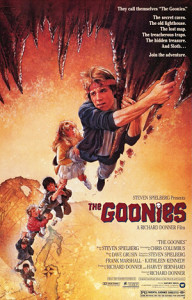 In The 40-Year-Old Critic, Venganza Media creator and host Arnie Carvalho recalls a memorable film for each year of his life. This series appears daily on the Venganza Media Gazette.
In The 40-Year-Old Critic, Venganza Media creator and host Arnie Carvalho recalls a memorable film for each year of his life. This series appears daily on the Venganza Media Gazette.
Tastes change through the ages. As a child I could not stand the bitterness of coffee, but now you wouldn’t want to engage me in conversation before my second cup. I also used to love maple sugar candy, a confection so sweet it made me gag when last I tasted it.
As it is with food and drink, so it is with movies.
Recently I attempted to watch The Goonies and I turned it off halfway through. It wasn’t the same.
But in 1985 I was a Goonie.
Executive produced by Steven Spielberg and directed by Superman’s Richard Donner, Goonies told the story of a group of pre-teen boys who lied to their parents, snuck out of the house, and saved the day. It was a film that continued a narrative Spielberg introduced in E.T.: a child outsmarting his parents and undertaking an adventure that would solve a family crisis and bring everyone closer together.
Surely every boy on the playgrounds of every school across America was the target audience for Donner’s film. Fat or thin, with or without braces, fast-talking or shy, there was a Goonie on screen with whom children and young teens could connect (Or at least every white child; the film lacked in diversity, with the only non-white child being an uncomfortable Asian stereotype).
For me, just 10 years old, I looked at the screen and saw myself as Mikey, the lead Goonie. Both of us were prone to flights of fancy, both of us would come up with crazy plans that often ended with my friends and I getting grounded, both of us still believed in the fantastical, and, hey, we were both asthmatic.
I was thrilled as the Goonies dodged booby traps and slid down a waterfall. I rocked out to the soundtrack featuring pop stars like Cindi Lauper and The Bangles. I shuddered when Chunk was locked in a room with the monstrous Sloth, and then cheered when the two became best friends and saved the day. I was engrossed as I watched the Goonies not only outsmart their parents, but also overcome the criminal Fratelli family. Truly this was a kid-power film if ever there was one!
At the time I didn’t see the movie for what it was: Indiana Jones for the playground set. Just look at all the booby traps, the majority of The Goonies could have been filmed on remnants left over from Temple of Doom.
Instead, I just went with the Goonie kids on their wild adventure to find One-Eyed Willy, and left the theater feeling that children could do anything. Parents were but unnecessary obstacles that tried to downplay the magical nature of the world.
This was the message I learned from so many films, from E.T. to Explorers to Cloak and Dagger to The Last Starfighter; but it was Goonies that drove it home. My childhood friends and I started to have our own misadventures, including the time we tried to catch some teenage drug-dealers by the mall, or when we started investigating ghosts that may or may not have haunted my house (both of these stories ended in humiliation and ruin).
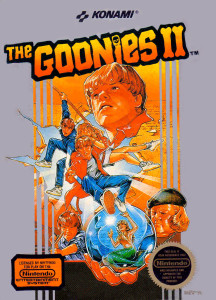
A couple years later my dream of Goonies 2 came true–but in a Nintendo game. My script was better; it didn’t have needless mermaids.
Even more though, if children could do anything, why couldn’t we actually be Goonies? By age 10 I was familiar with moviemaking — having watched many behind-the-scenes TV specials. I picked up movie magazines that had interviews and profiles with the actors and directors involved. The movie Clue, with its multiple, random endings, even started to give me ideas about marketing.
Not understanding the struggle child actors face trying to break into Hollywood, I was resentful of the Goonies casting and what I considered “Hollywood nepotism.” My Goonies Official Film Magazine made me realize all the Goonies were either actors who had been in other films (Corey Feldman and Jonathan Ke Quan) or children of famous people (Sean Astin and Josh Brolin). Obviously, boys from Springfield, Illinois, had no chance of being cast.
So I decided to make my own Goonies 2.
It had to happen — a 10-year-old boy obsessed with watching movies would surely turn into an 11-year-old who wanted to make movies. My parents had an 8mm film camera for family movies and, at age 8, I’d already filmed Star Wars 4: The Return of Darth Vader.
It’s a mostly ad-libbed, terribly embarrassing 10-minute-short that ended with Luke Skywalker and Darth Vader playing together in a swimming pool.
But I was now older, wiser, and had dreams of filmmaking.
Over the span of a month I hammered out a script for Goonies 2. The plot was simple enough: the jewels were not enough to save the homes and the Goonies had to go out and find even more money. With my best friend Stuart’s help we cast our friends and family in various roles. A group of us even successfully recreated some of Data’s gadgets, including a spring-loaded, belt-worn dart gun.
I clearly was not alone in this dream. Earlier this year I saw an episode of the ABC sitcom The Goldbergs in which lead character Adam tried the exact same thing! As this show is loosely based off the real life experiences of showrunner Adam Goldberg, I do wonder how many other kids across the country were inspired to grab cameras and try filmmaking because of this Donner-Spielberg adventure.
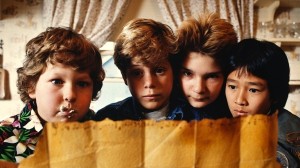
I felt “Good Enough” to hang with The Goonies
Fortunately, we never shot a frame of Goonies 2 — I doubt I could survive such embarrassment. The props were repurposed into a sixth-grade class performance for Goonies Cereal (we got an A). The script, typed in Wordstar on a NEC APC III, was lost when the 5.25-inch floppy was bent. My only memory of the script is my sister Linda saying she had memorized her dialogue. She was cast as Mama Fratelli, and all she did was scream.
Rewatching The Goonies recently, I imagine my 10-year-old self really did tap into the core of that film, because it’s full of screaming, shouting, hollering, and various other loud noises.
As an adult it was just an assault on my senses.
The film is too sugar-fueled, too chaotic, and too… kiddie for me to enjoy. But I will always have those memories of being 10 and dreaming I could be a Goonie.
So, if this were an episode of Now Playing Podcast, would I recommend The Goonies? Being a film critic means more than just saying “I liked a film.” Everyone has opinions, but an opinion is not a critique. While personal judgments will always play into a review, more must be taken into account in order to properly judge any creative work. Not every film is made for mass appeal, and sometimes focusing on a niche audience is key to a movie’s success. The Goonies clearly struck a chord with its core audience, and I can’t think of a higher recommendation than that.
Tomorrow — 1986!
Arnie is a movie critic for Now Playing Podcast, a book reviewer for the Books & Nachos podcast, and co-host of the collecting podcasts Star Wars Action News and Marvelicious Toys. You can follow him on Twitter @thearniec
August 15, 2014 Posted by Arnie C | 40-Year-Old Critic, Movies, Now Playing Podcast, Podcasts, Reviews | 1980s, 40-Year-Old Critic, Corey Feldman, Enertainment, Film, Goonies, Joey Pants, Josh Brolin, Movie, Movies, Review, Reviews, Richard Donner, Sean Astin, Sloth, Steven Spielberg | 1 Comment
40 Year-Old-Critic: E.T. the Extra-Terrestrial (1982)
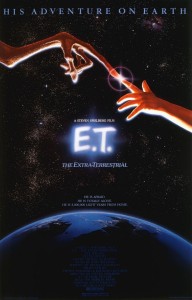 In The 40-Year-Old Critic, Venganza Media creator and host Arnie Carvalho recalls a memorable film for each year of his life. This series appears daily on the Venganza Media Gazette.
In The 40-Year-Old Critic, Venganza Media creator and host Arnie Carvalho recalls a memorable film for each year of his life. This series appears daily on the Venganza Media Gazette.
Movies are magic.
The commonplace nature of cinemas in the United States allow us to take for granted the power of cinema. Most of us live close to prolific multiplexes, so no effort is needed, no great journey undertaken, to get to a theater.
But once inside we enter a dark room and are taken far away from our everyday lives. It is so easy to fall into the world of a well-crafted movie that I often find myself lost in the experience. That magic of cinema makes me a movie lover to the point that I spend countless hours each week watching and reviewing films for Now Playing Podcast.
Because cinematic worlds are consumed so easily by moviegoers, it is easy to overlook the talent of hundreds, sometimes thousands, of people whose combined work creates a vision from nothing. I know as a very young child I never thought about who made a film. I never envisioned writers trying to sell a spec script, directors scouting for suitable locations, or puppet-makers designing detailed creatures. Despite loving Star Wars I didn’t know the name George Lucas. I just paid my two dollars and was taken to a galaxy far, far away.
But I can very clearly remember the year in my life when that simplistic view of movies changed, and I realized movies were made by people — and certain people made films better than others.
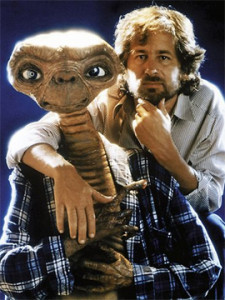 I was 7 years old, the year was 1982, and the film that made it clear was Steven Spielberg’s E.T. the Extra-Terrestrial.
I was 7 years old, the year was 1982, and the film that made it clear was Steven Spielberg’s E.T. the Extra-Terrestrial.
I didn’t know Spielberg’s name, nor his work. Jaws, Close Encounters of the Third Kind and Raiders of the Lost Ark may have been the films that made the director a household name, but as a young child that was lost on me.
The first time I paid attention to his name was a Saturday night in the spring of ‘82. Despite my age, my Saturday night ritual was to watch Siskel & Ebert At The Movies. I was interested in which movies deserved the coveted “Thumbs Up” from the critics, but more than that I loved seeing the clips of so many different movies all in a half-hour. Through these two iconic critics I was exposed to more movies than my parents would allow me to see.
On this particular Saturday night Gene Siskel and Roger Ebert showed a movie clip from E.T. that fascinated and scared me. It was the scene where Elliott rolls a baseball into the shed, and it comes back out. He runs in and gets his family, and his older brother, Michael, looks down at the alien footprints in the dirt and declares, “The coyote’s come back again, Ma.”
The pre-release materials never allowed audiences to view the alien creature — you had to pay admission to see it — but from that trailer I felt there was something dangerous and wondrous in that shed. I thought E.T. was a horror film and I thought Elliott was in grave danger from the unseen beast, but I wanted to know more.
In their review Gene Siskel and Roger Ebert repeatedly referenced director Steven Spielberg.
 I remember going to see E.T. opening weekend. Unlike Raider’s of the Lost Ark the year before, I would not miss this film. But I needn’t have feared — going was a family event. For a change it wasn’t just the science-fiction obsessed boy in the house demanding to see the movie. Everyone, from my workaholic, absentee father to my pragmatic mother to all three of my teenaged sisters, wanted to see this movie.
I remember going to see E.T. opening weekend. Unlike Raider’s of the Lost Ark the year before, I would not miss this film. But I needn’t have feared — going was a family event. For a change it wasn’t just the science-fiction obsessed boy in the house demanding to see the movie. Everyone, from my workaholic, absentee father to my pragmatic mother to all three of my teenaged sisters, wanted to see this movie.
Being a large family with children ranging from 7 to 19, whole-family outings to a movie theater were rare. But this was one of those occasions. I remember the six of us taking up a good portion of the row, and how I was once again transported into the world Spielberg created. I also remember crying at the end, and trying desperately not to.
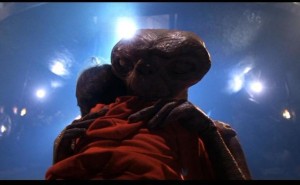 As a child I was very sensitive. I also was not wholly unfamiliar with the idea of a bittersweet ending. My sister Susan helped me remember watching a rerun of the 1978 TV special Puff the Magic Dragon and how at the end Puff flew off, leaving Jackie alone. I didn’t understand then the importance of Jackie’s transformative experience with Puff, I just saw a boy losing his friend. I heard the line, “Dragons live forever, not so little boys” and I cried. Hard. My father, however, had no sympathy and chastised his 4-year-old son for getting emotional over a television show.
As a child I was very sensitive. I also was not wholly unfamiliar with the idea of a bittersweet ending. My sister Susan helped me remember watching a rerun of the 1978 TV special Puff the Magic Dragon and how at the end Puff flew off, leaving Jackie alone. I didn’t understand then the importance of Jackie’s transformative experience with Puff, I just saw a boy losing his friend. I heard the line, “Dragons live forever, not so little boys” and I cried. Hard. My father, however, had no sympathy and chastised his 4-year-old son for getting emotional over a television show.
Now here it was just a few years later and that Puff ending was replayed with E.T. leaving Elliott, and once more I was crying. My father was sitting just a few seats away, and I tried to hold in the tears. I failed, and left the theater sobbing.
I also left that theater changed. The film had engrossed me, and I’m told I wouldn’t stop talking about it for weeks to come.
More, I kept going back to see it. The second time I saw E.T. I went with Stuart, whom I had met the previous year in grade school. Knowing the ending in advance, I told myself I’d hold it together. I did better, but when the credits rolled my lower lip was quivering and tears streamed down my face. Then I saw it with my godparents, then a babysitter, then my mother’s friend who took me, both to occupy me one afternoon and to see the film herself.
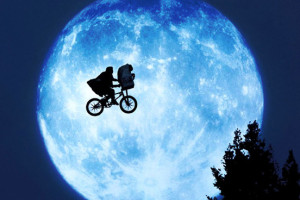 Going to see E.T. became a habit. I ended up seeing it about a dozen times in theaters.
Going to see E.T. became a habit. I ended up seeing it about a dozen times in theaters.
Then I started to seek out more about Spielberg. I started to connect that name with Raiders of the Lost Ark and other films both at the video store and in theaters. Through At The Movies I became more exposed to the people behind the camera, as well as in front of it. But no matter how many names I learned, Spielberg’s was special from that moment with E.T.
That film was a massive success, dethroning Star Wars as the highest-grossing picture of all time. As such, the number of “Spielberg films” exploded, from Gremlins to Goonies, Indiana Jones and the Temple of Doom to Back to the Future, Poltergeist and even An American Tail (which, at 12, I felt far too old to see in theaters, but went for Spielberg). I sought them all out.
The lesson I learned as a 7-year-old took many more years to sink in fully. I spent my teen years following actors instead of filmmakers. I would enjoy a film with Corey Feldman, John Candy, or Eddie Murphy and wanted to see more of them, but I was repeatedly disappointed by the uneven nature of their performances. Finally, later in life, I would relearn the childhood lesson, as I started to appreciate films for those who made them. I would follow the careers of Oliver Stone, Quentin Tarantino, Richard Linklater, Darren Aronofsky, and others.
But Spielberg was the first auteur to excite me — at just 7 years old — as I watched E.T. phone home again and again.
Next — 1983!
Arnie is a movie critic for Now Playing Podcast, a book reviewer for the Books & Nachos podcast, and co-host of the collecting podcasts Star Wars Action News and Marvelicious Toys. You can follow him on Twitter @thearniec
August 12, 2014 Posted by Arnie C | 40-Year-Old Critic, Movies, Now Playing Podcast, Podcasts, Reviews | 1982, 40-Year-Old Critic, Be Good, E.T., E.T. the Extra-Terrestrial, ET, Movie, Review, Reviews, Steven Spielberg | Comments Off on 40 Year-Old-Critic: E.T. the Extra-Terrestrial (1982)
40 Year-Old-Critic: Raiders of the Lost Ark (1981)
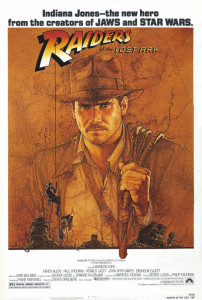 In The 40-Year-Old Critic, Venganza Media creator and host Arnie Carvalho recalls a memorable film for each year of his life. This series appears daily on the Venganza Media Gazette.
In The 40-Year-Old Critic, Venganza Media creator and host Arnie Carvalho recalls a memorable film for each year of his life. This series appears daily on the Venganza Media Gazette.
I wrote at length about the summer blockbuster in the 1975 installment of this retrospective series discussing Jaws. I recalled how it seemed each year had one movie that everyone was talking about. Hollywood now gives its tentpole pictures one or two weeks to make an impact, but when I was a kid the biggest films ran for months and would remain in the public conversation for years.
In 1981 I learned what it was like to be on the outside of that conversation.
I spent a lot of time at the movies as a kid. I remember a summer program in our town that screened older, child-friendly films each week for just $1 — a small price for my mother to pay to have me sit quietly for two hours. My mother, my godmother, and my sister would coordinate schedules to take me to see those summer films and, being the completist that I am, I refused to miss a single installment.
Not content with the preprogrammed children’s fare, I started to make my own decisions about which new releases I would see. I remember begging my mother to take me to Clash of the Titans, The Great Muppet Caper, Superman II, and The Fox and the Hound. But one film that totally escaped my attention was Raiders of the Lost Ark.
By the summer of ‘81 Steven Spielberg was already a name-brand director with blockbusters Jaws and Close Encounters of the Third Kind under his belt. He’d survived a rare misstep with the ill-conceived 1979 comedy 1941 and returned to form two years later with the first installment in the Indiana Jones franchise.
This film carried more than just Spielberg’s golden name. The poster boasted “From the creators of Jaws and Star Wars.” It was Spielberg’s collaboration with the man who had made the most successful film of all time… George Lucas.
With those names on the poster it is no shock that moviegoers turned out in droves to see the film, with no misgivings about its period setting — a far cry from the filmmakers’ recent science-fiction fare. Plus Raiders wisely featured a strong supernatural bent for those who appreciated the fantastical elements of Close Encounters and Star Wars.
Raiders of the Lost Ark went on to become the top-grossing film of 1981. It was a cultural smash, a critical darling, and nominated for several Academy Awards.
I totally missed it.
The first Indiana Jones movie opened in our town on June 12 — the same day as Clash of the Titans. I didn’t just choose to see Greek gods over Indiana Jones, I have no memory of knowing Raiders of the Lost Ark was out there. Soon after, Superman II opened, and that was the movie I’d been waiting to see.
Raiders was totally lost on me.
When school resumed that fall it didn’t take long for me to realize I’d missed something huge. Now a second-grader, I returned to classrooms ready to reunite with schoolyard friends and talk about Clash of the Titans and Superman II, but the only movie on their minds starred some guy with a whip. Playground chums regaled me with tales of the swordsman who performed deft moves only to be quickly shot dead, and that magical box that made Nazi faces melt. I had nothing to add to these conversations, I could only nod and say it sounded fun.
 This feeling of isolation continued for years, and I felt Raiders of the Lost Ark would taunt me forever. For Christmas in 1982 my sister Susan bought me the Raiders of the Lost Ark Atari 2600 game. She was now a college student and assumed I’d seen the film and loved it. I played that game for days, trying to use it as a surrogate for the movies I’d missed. I created a story in my mind featuring snakes and whips and anchs and black markets.
This feeling of isolation continued for years, and I felt Raiders of the Lost Ark would taunt me forever. For Christmas in 1982 my sister Susan bought me the Raiders of the Lost Ark Atari 2600 game. She was now a college student and assumed I’d seen the film and loved it. I played that game for days, trying to use it as a surrogate for the movies I’d missed. I created a story in my mind featuring snakes and whips and anchs and black markets.
Finally, the next year, my long nightmare ended.
In late 1982 my family bought our first VCR and, a few months later, we rented Raiders of the Lost Ark on VHS. Of course, I loved the film (and was surprisingly happy to see how little it resembled its Atari counterpart). It was exciting and funny, and also a bit scary. I had nightmares for months about those melting faces. Though I would rewatch Raiders regularly on video, for the first year or more I would cover my own eyes during the bloody climax.
Then, in 1984, when Indiana Jones and the Temple of Doom was released, I ensured I didn’t make the same mistake — I saw the sequel twice on opening weekend and read the novelization.
I still watch Raiders of the Lost Ark regularly to this day (though I now laugh at the effects that made me wince as a child). Just this past summer I went on a fishing trip with friends and we gathered around the cabin’s small television to watch Harrison Ford in his second-best role. We applauded its genius, debated the importance of Indy in the movie’s plot, and lamented the franchise’s abysmal fourth installment.
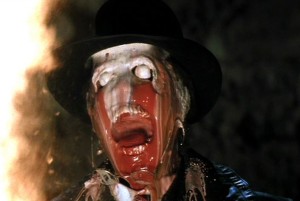 Raiders of the Lost Ark was the best film of 1981, but it also taught me the importance of cinema as part of a cultural conversation. Shared experience creates a community, and in the 1980s part of our nationwide identity was defined by blockbuster films. National defense programs were named after sci-fi flicks, presidential candidates quoted hit movies, and playground friendships were made and broken by what you saw over summer vacation.
Raiders of the Lost Ark was the best film of 1981, but it also taught me the importance of cinema as part of a cultural conversation. Shared experience creates a community, and in the 1980s part of our nationwide identity was defined by blockbuster films. National defense programs were named after sci-fi flicks, presidential candidates quoted hit movies, and playground friendships were made and broken by what you saw over summer vacation.
I do feel that today some of the magic is lost when there is a new “must see” movie every weekend. It waters down the experience. Now there are more fractured groups of fans, and rarely is there a film like Titanic, Star Wars, E.T., or Raiders of the Lost Ark that can transcend age, race, and gender and become a cultural phenomenon.
At 6 years old I learned how important that was, thanks to Raiders, and it’s a belief I hold today.
Next — 1982!
Arnie is a movie critic for Now Playing Podcast, a book reviewer for the Books & Nachos podcast, and co-host of the collecting podcasts Star Wars Action News and Marvelicious Toys. You can follow him on Twitter @thearniec
August 11, 2014 Posted by Arnie C | 40-Year-Old Critic, Movies, Now Playing Podcast, Podcasts, Reviews | 1981, 40-Year-Old Critic, Clash of the Titans, George Lucas, Harrison Ford, Indiana Jones, Now Playing, Now Playing Podcast, Podcasts, Raiders of the Lost Ark, Review, Reviews, Steven Spielberg, Superman | 4 Comments
40 Year-Old-Critic: Jaws (1975)
 In The 40-Year-Old Critic, Venganza Media creator and host Arnie Carvalho recalls a memorable film for each year of his life. This series appears daily on the Venganza Media Gazette.
In The 40-Year-Old Critic, Venganza Media creator and host Arnie Carvalho recalls a memorable film for each year of his life. This series appears daily on the Venganza Media Gazette.
My childhood was defined by the summer blockbuster. Each year I can think of one, and only one, major movie that held me — and the entire country it seemed — in its thrall. E.T. (1982), Return of the Jedi (1983), Jurassic Park (1993), Independence Day (1996), the list goes on. Each year there seemed to be one film that unified audiences, and I could discuss this film with everyone I met. I never thought about why this was the case, it simply was a fact.
What I didn’t realize for more than thirty years was that the summer blockbuster phenomenon had not always been, but rather started just before my first birthday with the release of Steven Spielberg’s Jaws.
The director’s breakthrough film didn’t have an immediate impact on me. Jaws had become part of our cultural lexicon by the time I was able to speak. John Williams’ theme music was omnipresent in films and television, the film’s dialogue was quoted regularly, and the ride was a staple at Universal Studios theme park. As such, I never felt the need to watch Jaws — I figured pop culture had exposed me to all I needed to know. I even saw Jaws 3D before viewing the Spielberg original, the red-and-blue gimmick glasses drawing me in 1983.
Finally, in 2011, as part of Now Playing Podcast’s Spring Donation Drive (an exclusive series for donors) I watched the original Jaws and realized I only thought I knew that movie.
Jaws is not just Spielberg’s breakthrough picture, it’s the original blueprint for the stereotypical “Steven Spielberg Film.” Though it’s based on Peter Benchley’s novel, Spielberg initiated several rewrites to the script to make the film more fun, the characters more likable, and the ending more explosive.
T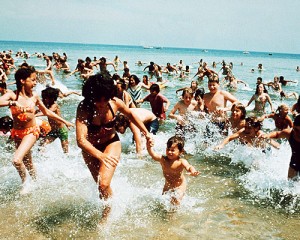 he story follows Amity Island Police Chief Martin Brody (Roy Scheider), a man who must defend his family and his town from a man-eating shark. While the story is presumably about the hunt for the shark, the film focuses more on Amity Island town politics and Brody’s relationship to his wife and children. Creating relatable character drama with a backdrop of extraordinary events is the hallmark of Spielbergian filmmaking, and it all started here with a shark tale.
he story follows Amity Island Police Chief Martin Brody (Roy Scheider), a man who must defend his family and his town from a man-eating shark. While the story is presumably about the hunt for the shark, the film focuses more on Amity Island town politics and Brody’s relationship to his wife and children. Creating relatable character drama with a backdrop of extraordinary events is the hallmark of Spielbergian filmmaking, and it all started here with a shark tale.
The result became his cinematic template — the way Amity Island is made real with its cast of colorful characters is echoed in Spielberg films I had seen throughout my childhood, films like E.T., Poltergeist, Gremlins and Goonies. I was dumbstruck when I realized that with Jaws, Spielberg created a narrative that he would copy, and see imitated by others, for decades.
The impact of Jaws, obviously, was felt even more at the box office. It changed moviegoing forever. Until that summer, Hollywood viewed the winter months as the time to release its blockbuster films; summer was a dumping ground for under-performers. But first with Jaws and, a few years later, Star Wars, Hollywood studios began to program the “summer movie.” More, the summer blockbuster had a type: high-concept, audience-pleasing characters, ever-improving special effects.
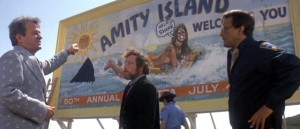 These films captivated moviegoers year-after-year, and throughout the 1980s I was one of the summer masses going to theaters for every big opening day. It was the heirs to Jaws’ legacy that made me love movies.
These films captivated moviegoers year-after-year, and throughout the 1980s I was one of the summer masses going to theaters for every big opening day. It was the heirs to Jaws’ legacy that made me love movies.
It took me 36 years to get around to watching Jaws, but when I did I immediately recognized that this film’s DNA was passed on to all of the favorite films from my youth.
Tomorrow — 1976!
Arnie is a movie critic for Now Playing Podcast, a book reviewer for the Books & Nachos podcast, and co-host of the collecting podcasts Star Wars Action News and Marvelicious Toys. You can follow him on Twitter @thearniec
August 5, 2014 Posted by Arnie C | 40-Year-Old Critic, Now Playing Podcast, Podcasts, Reviews | 40-Year-Old Critic, Arnie, Jaws, Now Playing, Now Playing Podcast, Review, Shark, Steven Spielberg, Summer Blockbuster | 6 Comments
-
Archives
- February 2021 (1)
- January 2021 (1)
- December 2020 (1)
- November 2020 (3)
- October 2020 (2)
- September 2020 (1)
- August 2020 (2)
- July 2020 (1)
- June 2020 (1)
- May 2020 (1)
- April 2020 (3)
- March 2020 (2)
-
Categories
-
RSS
Entries RSS
Comments RSS
Site info
Venganza Media GazetteTheme: Andreas04 by Andreas Viklund. Get a free blog at WordPress.com.
